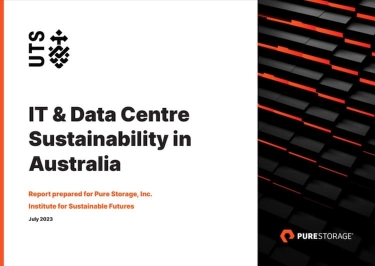The IT and Data Centre Sustainability in Australia report was based on a survey of 103 sustainability professionals during May and June 2023, and found while they believe they can't meet their sustainability goals without reducing IT and data centre energy use, they don't have the detailed data they need to make decisions.
For example, only 48% of respondents were fully aware or had some awareness of the amount of energy that data centres consume.
Organisations cannot reach their sustainability goals without significantly reducing IT and data centre energy usage, according to 77% of respondents, yet only 5% felt that the quality of sustainability-related data received from data centre service operators was detailed enough. Indeed, 46% said they receive no such data.
|
|
Furthermore, while over 70% of respondent organisations had sustainability of data centres on their radar, only 15% of respondents said it was a critical consideration in data centre procurement, and just 22% thought their organisation pays sufficient attention to data centre energy consumption.
Australia is already one of the most densely served economies by data centres per capita, and the market is expected to grow, in part due to the adoption of AI and other technologies.
Hence it should be "concerning that Australian organisations appear to not be taking the steps necessary to incorporate data centre and IT related emissions into account when managing their environmental, social and governance (ESG) and carbon emissions reduction programs," according to the report.
Noting overseas experience, it suggests "Australian businesses and policy makers need to avoid the risk of adding to the instability of the country's energy grid," otherwise we may be forced to choose between cooling homes or data centres on extreme heat days.
"Our recommendations are for Australia's financial system, including corporations, banks and investors to work with the Australian Government to develop a framework for IT and data centre sustainability roadmaps that would provide harmonised reporting of:
• Climate-related sustainability data aligned with international climate-related financial reporting standards.
• Social and governance management practices including reporting of data protection standards and sovereignty of data arrangements.
• The NABERS rating of data centre facilities.
• Whether an organisation has incorporated data services into a science-based net zero transition plan."
"Data centres are exposed to significant ESG risks that have largely escaped the attention of investors and sustainability managers. Improved awareness of data centre sustainability is urgent as we move into a new era where businesses rely even more heavily on data in their businesses and depend on energy and cooling intensive data centres. There are real and increasing risks for investors, and regulators around uncertainty over how companies manage, account for, and act to reduce their emissions," said UTS Institute for Sustainable Future business, economy and governance research director Gordon Noble, who was lead author of the report.
"With the use of data growing ever more exponentially, including with AI and data centres, it is important that organisations recognise the role their IT and data centres are playing in their emissions footprint. There are also implications for government policy makers."
Noble suggested part of the problem is that IT and sustainability professionals are generally not working well together at present. Technology can be "intimidating" to sustainability managers, and because they have to deal with so many issues, IT is not always at the centre of their attention.
This was highlighted by the way one third of respondents did not even know whether their organisations operate their own data centres or use external providers.
Pure Storage's interest in this area can be seen from its claims that its all-flash storage arrays use up to 80% less power than competing products, occupy less space per terabyte, and generate less e-waste due to their reliability and longevity.
Pure Storage CTO Rob Lee cited the experience of a large, Europe-based bank that saw an 88% reduction in direct energy use, a 94% smaller data centre footprint, and annual operational cost savings of $1.9 million by replacing a small proportion of its storage estate with Pure arrays.
He said "With data continuing to grow, energy and space efficiency must play a stronger role in IT and data centre technology selection. IT leaders can and should play a bigger role in their organisation's sustainability initiatives by improving their data storage strategies.
Pure Storage ANZ area vice president Amy Rushall added "This report is a wakeup call for both government and private enterprises in Australia that more attention needs to be paid to energy consumption in data centres. The pace of technology adoption will continue to accelerate but this should not compromise our attention to the environment."










































